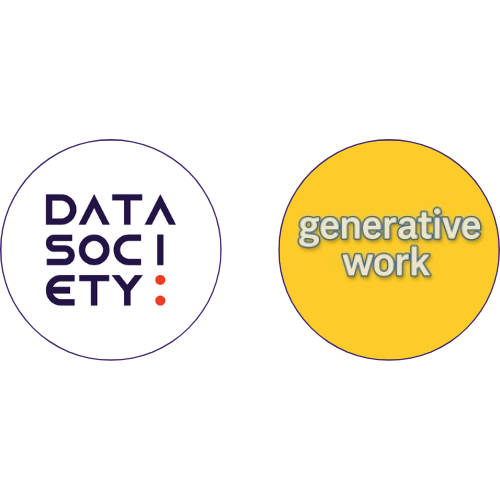Most organizations want to be more data-driven. But wanting it and building it are two very different things.
Creating a data driven culture means more than adopting new tools, it requires a mindset shift across teams and leadership. Dmitri Adler, Co-Founder of Data Society, argues that the most effective way to embed data into decision-making is to start with clarity.
“Leaders have to provide clarity about how decisions will be made,” he says. “You need to be clear with the organization about the cause-and-effect relationships that drive the success of the firm.”
To lead with data, leaders must define not only what data matters, but how it’s used to shape strategic choices across the organization.
LEARN MORE: Data Literacy vs. Data Fluency: Understanding the Key Differences
Step 1: Build a Shared Decision-Making Framework
It’s not possible, or even desirable, for leadership to be in every room where decisions are made. That’s why Adler recommends adopting a principle borrowed from military leadership: commander’s intent.
“The boss can’t be in the room when every decision is made, but the rank and file need to have a sense for how the boss makes decisions,” Adler says. “You establish a framework, you explain and demonstrate that process, and you do it often.”
In a strong data driven culture, this approach allows employees to act with confidence, using shared data and decision frameworks to guide their actions. When leaders lead with data, they create alignment across the organization, making it easier for teams to respond to challenges without waiting for top-down approval.
Step 2: Equip Your Teams

A clear framework means little without the tools to act on it. Data driven decision-making requires more than access to dashboards or reports. It demands the ability to interpret, question, and apply insights effectively. This combination of tools, skills, and support is what differentiates a buzzword from a true data driven culture.
“You’re going to get a very defeated workforce if you tell them to do something that is impossible with the resources they have,” Adler warns.
To lead with data in a way that empowers rather than overwhelms, organizations must take deliberate steps to support their teams:
Identify available tools. Audit current data systems to ensure they’re usable, integrated, and accessible to the people who need them most.
Invest in data literacy. Training shouldn’t be limited to technical roles. Every employee should feel confident understanding the data they’re expected to use.
Communicate expectations clearly. When people know how their data use connects to business goals, they’re more likely to engage thoughtfully and take initiative.
Building a data driven culture isn’t about pushing data from the top down. It’s about creating an environment where data informs decisions at every level. When people have what they need, they can act with clarity and confidence.
MUST READ: Data Literacy for All: Empowering Individuals and Organizations with Data Skills
Step 3: Tie Data to Career Growth
One of the most overlooked levers in change management is individual motivation. A successful data driven culture doesn’t just depend on systems and strategy—it depends on people choosing to engage.
“You need to demonstrate how being data-driven ties into promotion schemes, compensation plans, and skill development,” Adler says. “If you do that well, people will want to stay. They’ll want to contribute.”
To truly lead with data, organizations must connect data practices to what matters most to their teams. When employees see that data fluency leads to professional growth and recognition, motivation increases, and so does the quality of decision-making.
Step 4: Balance Internal and External Expertise
You don’t have to build everything in-house. In fact, trying to do so can stretch teams too thin or limit innovation. Adler recommends a hybrid approach that balances internal expertise with external support.
“In-house experts will know your organization better than anybody else. External experts offer flexibility and a broader perspective. The art is deciding how much of each you need based on your specific situation.”
This blend is especially powerful for organizations looking to lead with data. Internal teams bring institutional knowledge, understand existing workflows, and can serve as long-term champions of change. External partners bring specialized skills, objectivity, and exposure to best practices across industries.
When done well, this model allows companies to maintain agility while scaling capability. It also reinforces a data driven culture by giving internal teams room to grow while tapping into outside expertise where needed. Whether launching a new analytics initiative or evolving decision-making processes, the goal isn’t to outsource thinking—it’s to build a support system that accelerates impact.
Data-Driven Cultures Are Built, Not Bought
At the end of the day, this isn’t about dashboards or platforms. It’s about behavior. Sustainable transformation happens when people consistently act on data, not just when they have access to it.
“You need to collect data on what your staff actually has access to,” Adler says. “And you need to communicate that information systematically, not just flood people with noise.”
To lead with data, leaders must go beyond visibility. They need to create conditions for data-informed action: clear access, relevant context, and ongoing reinforcement. That means aligning tools, training, and expectations across the organization.
Building a data driven culture is not a one-time rollout. It is iterative. It is personal. And it is leadership-led. It starts with clarity and succeeds with consistency when behavior shifts from intention to habit.
Want to turn data-driven strategy into daily decision-making? Data Society helps leadership teams operationalize data culture from the top down. Contact us to take the first step.
Q&A: Practical Steps for Leaders to Drive with Data
Many leaders assume it’s a technology problem. But according to Dmitri Adler, Co-Founder of Data Society, the real challenge lies in behavior, specifically, how decisions are made and communicated across the organization.

